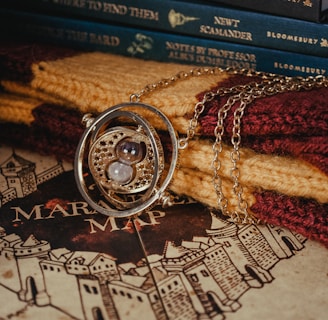Adapter and Flyweight Patterns in Java: Explored with Harry Potter
Introduction
In the world of software development, design patterns play a crucial role in creating efficient and maintainable code. Two such patterns that are commonly used in Java are the Adapter Pattern and the Flyweight Pattern. In this article, we will explore these patterns using examples inspired by the magical world of Harry Potter. We will also discuss where and how you can find and use these patterns in your own projects.
The Adapter Pattern
The Adapter Pattern is a structural design pattern that allows incompatible interfaces to work together. It acts as a bridge between two incompatible classes, enabling them to collaborate seamlessly. The following code utilizes the Adapter Pattern in a Harry Potter context, introducing Dobby the House-Elf as a transformative Adapter, akin to his role of revealing secrets and warnings, by adapting information from his former master, Lucius Malfoy, to Harry Potter.
To implement the Adapter Pattern, we create an adapter class that implements the interface of one class and wraps an instance of the other class. In our example, we can create a scenario where Dobby, the House-Elf, acts as the Adapter class, mediating information from Lucius Malfoy (class) to Harry Potter (interface). This represents the role of an Adapter, mirroring Dobby's function of transmitting secrets and warnings from the dark lord to Harry Potter in the wizarding world.
Here's a simplified code example to illustrate the Adapter Pattern in action:
// Interface for Magical Creatures
interface MagicalCreature {
void performMagic();
void knowingSecrets();
}
// Class representing a House-Elf
class HouseElf {
void serveMaster() {
System.out.println("House-Elf serving its master.");
}
}
// Adapter to enable House-Elf to serve Harry Potter
class DobbyAdapter implements MagicalCreature {
private HouseElf dobby;
public DobbyAdapter(HouseElf dobby) {
this.dobby = dobby;
}
public void performMagic() {
System.out.println("Dobby, the House-Elf, serves Harry Potter.");
dobby.serveMaster("Harry Potter");
}
public void knowingSecrets() {
System.out.println("Dobby, the House-Elf, warns Harry Potter.");
dobby.serveMaster("Harry Potter");
}
}
// Main Class
public class HarryPotterAdapterExample {
public static void main(String[] args) {
// Creating a new House-Elf (Dobby)
HouseElf dobby = new HouseElf();
// Using DobbyAdapter to enable Dobby to serve Harry Potter
MagicalCreature dobbyAsCreature = new DobbyAdapter(dobby);
// Dobby serving Harry Potter and warning him
dobbyAsCreature.performMagic();
dobbyAsCreature.knowingSecrets();
}
}
The MagicalCreature interface defines methods for performing magic and knowing secrets. The HouseElf class represents a House-Elf's natural ability to serve its master. To enable House-Elves to perform magic and share secrets, we use the Adapter Pattern. The DobbyAdapter class implements the MagicalCreature interface and contains a reference to a HouseElf.
When creating a DobbyAdapter instance and pass a HouseElf (such as Dobby) to it, Dobby can now perform magic indirectly, serves Harry Potter and warning him. Invoking dobbyAsCreature.performMagic() internally calls dobby.serveMaster(), allowing Dobby to indirectly perform magic by serving Harry Potter. Similarly, invoking dobbyAsCreature.knowingSecrets() internally calls dobby.serveMaster(). This action allows Dobby to indirectly warn Harry Potter.
This demonstrates the Adapter Pattern's role in adapting interfaces to facilitate new functionalities.
Here is an UML-Diagramm which illustrates the adapter pattern of an object: the adapter implements the interface of one object and wraps the other one.
Where to use the adapter pattern:
🎮 Use the adapter class when faced with an existing class that doesn't quite align with your code's interface, the Adapter class comes to the rescue.
⚡️ This pattern acts as a middle-layer, bridging the gap between your code and an incompatible legacy or 3rd-party class.
🎮 Imagine needing to reuse multiple existing subclasses but finding they lack a common functionality. While one approach involves extending each subclass to add this functionality, it leads to code duplication across multiple classes.
⚡️ Instead, an elegant solution lies in an adapter class. By encapsulating missing functionalities within an adapter, you would wrap the needed features into objects. For this to work seamlessly, the target classes must share a common interface, similar to the structure seen in the Decorator pattern.
The Flyweight Pattern
The Flyweight Pattern, a structural design paradigm, seeks to conserve memory by sharing common data among multiple objects. It is especially useful when you have a large number of similar objects that can share common state. In the realm of Harry Potter, envision a scenario where an array of spells exists, each unique in its incantation, but sharing certain core properties, like the name and potency level. Instead of creating a new instance for each spell, employing the Flyweight Pattern would unify such shared attributes, markedly optimizing memory usage.
Implementing the Flyweight Pattern demands a classification of an object's traits into intrinsic and extrinsic states. Intrinsic states encapsulate shared properties among objects, while extrinsic states embrace unique attributes. Translating this to our spell scenario, the spell's name and potency serve as intrinsic states, while the target and effect manifest as extrinsic states.
Here's the code example without utilizing the Flyweight Pattern:
class Spell {
private String name;
private int powerLevel;
public Spell(String name, int powerLevel) {
this.name = name;
this.powerLevel = powerLevel;
}
public void cast(String target, String effect) {
System.out.println("Casting " + name + " on " + target + " with effect: " + effect);
}
}
public class Main {
public static void main(String[] args) {
Spell spell1 = new Spell("Expelliarmus", 5);
Spell spell2 = new Spell("Expelliarmus", 5);
Spell spell3 = new Spell("Avada Kedavra", 10);
spell1.cast("Draco Malfoy", "Disarming");
spell2.cast("Bellatrix Lestrange", "Disarming");
spell3.cast("Voldemort", "Killing");
}
}
In this modified version, each Spell object is directly instantiated without using a factory method or a cache to retrieve existing instances. As a result, each call to create a new Spell object will result in a separate instance in memory, even if the properties (name and power level) are the same. This can lead to higher memory usage when multiple identical Spell objects are created.
Here's the simplified code snippet to demonstrate the Flyweight Pattern in Java:
import java.util.HashMap;
import java.util.Map;
// Represents a spell with a name and power level
class Spell {
private final String name;
private final int powerLevel;
// Constructor to initialize the spell with a name and power level
public Spell(String name, int powerLevel) {
this.name = name;
this.powerLevel = powerLevel;
}
// Method to cast the spell on a target with a specific effect
public void cast(String target, String effect) {
System.out.println("Casting " + name + " on " + target + " with effect: " + effect);
}
}
// Factory class to create and manage spells
class SpellFactory {
// Cache to store unique spell instances
private static final Map spellCache = new HashMap<>();
// Method to retrieve a spell from the cache or create a new one if not present
public static Spell getSpell(String name, int powerLevel) {
String key = name + "_" + powerLevel;
// If the spell is not present in the cache, create and add it
// Using computeIfAbsent method to avoid duplicate spell creation
return spellCache.computeIfAbsent(key, k -> new Spell(name, powerLevel));
}
}
// Main class to demonstrate the Flyweight Pattern
public class Main {
public static void main(String[] args) {
// Get instances of spells from the factory
Spell spell1 = SpellFactory.getSpell("Expelliarmus", 5);
Spell spell2 = SpellFactory.getSpell("Expelliarmus", 5);
Spell spell3 = SpellFactory.getSpell("Avada Kedavra", 10);
// Cast spells on different targets with specific effects
spell1.cast("Draco Malfoy", "Disarming"); // Casting Expelliarmus on Draco Malfoy with effect: Disarming
spell2.cast("Bellatrix Lestrange", "Disarming"); // Casting Expelliarmus on Bellatrix with effect: Disarming
spell3.cast("Voldemort", "Killing"); // Casting Avada Kedavra on Voldemort with effect: Killing
}
}
The code maintains a SpellFactory acting as a repository for Spell objects. By employing a caching mechanism, it provides pre-existing instances when spells with similar properties are requested. This approach considerably reduces memory usage by sidestepping redundant object creation, thereby optimizing system performance. The pattern is employed within the SpellFactory class, primarily in the getSpell method.
This example delves into the intricacies of the Flyweight Pattern, explaining its impact on memory optimization in a Harry Potter-inspired spell-casting scenario.
Where to Find and Use These Patterns
The Adapter Pattern and the Flyweight Pattern are widely used in various domains of software development. You can find them in frameworks, libraries, and even in the core Java API. Here are some common scenarios where you can apply these patterns:
Adapter Pattern:
- When integrating with third-party libraries or APIs that have incompatible interfaces.
- When you want to reuse existing classes that don't implement a required interface.
- When you need to decouple client code from the implementation details of a class.
Flyweight Pattern:
- When you have a large number of similar objects that can share common state.
- When memory usage is a concern and you want to optimize it by reducing object creation.
- When you need to represent a large amount of data efficiently.
By understanding and applying these patterns, you can improve the design and performance of your Java applications. They provide elegant solutions to common problems and promote code reusability and maintainability.
Conclusion
In this article, we explored the Adapter Pattern and the Flyweight Pattern in the context of Java development, using examples inspired by the magical world of Harry Potter. We discussed how the Adapter Pattern allows incompatible interfaces to work together, and how the Flyweight Pattern minimizes memory usage by sharing common state among similar objects. We also discussed where and how you can find and use these patterns in your own projects. By leveraging these patterns, you can write more efficient and maintainable code. So go ahead and apply these patterns in your projects, and let the magic unfold!


